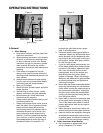
12
the body if needed — safety eye glasses,
gloves, earplugs, boots, hats, etc.
WARNING:
Hearing Protection is required for all operator
exposure exceeding two (2) hours.
b. Ensure that the area is free of animals and
bystanders, especially children!
c. Survey the area where the equipment is to
be used to make sure it is free of debris,
sticks, stones, wires, bones, and other for-
eign objects which could cause injury to
bystanders, damage to the machine, or
damage to nearby facilities.
d. Inspect the machine to make sure:
1. All guards, shields (including mower
chute deflector) are in their proper place,
are secure, and are functional.
2. That there are no spilled or leaking fuel
or oil sources, nor loose fuel or hydraulic
tank caps, hoses or fittings.
3. That there are no loose or missing hard-
ware nor any missing items.
4. That no non-approved devices are
installed.
5. That all safety signs and decals are
properly installed and legible.
e. This is a one person machine, operator
only! Riders are not permitted under any
circumstance!
f. To start the engine on the machine:
1. Make sure the park brake is set to the
“ON” position, both lap bars are in the
neutral position, and the Power Take Off
(PTO also referred to as blade control
switch) is in the “off” (down) position.
2. Move the choke control forward and the
engine speed control (throttle) forward
(half way).
3. Insert the ignition key, turn the switch
toward the spring-loaded “Start” position,
maintain the Start position until the
engine begins to run, then release the
switch (it will return to the “Run” posi-
tion).
4. Retard the choke slowly by moving it
rearward. If the engine is “cold”, the
choke may need to be partially applied
for a few minutes. Be sure to totally
retard the choke after the engine has
“warmed up”.
g. Check safety devices:
1. With the park brake engaged, move one
of the lap bars (speed/directional control)
from the neutral position toward the front
of the machine — the engine should
stop running. Move the lap bars back to
the neutral position and the engine
should run.
2. Repeat this procedure with the opposite
side lap bars.
3. With the park brake engaged and the lap
bars in the neutral position, advance the
engine speed control completely forward
(Hi-idle), engage the PTO control switch
(pull upward), then lift off the seat — the
engine should stop running. Sit down
and the engine should run. Turn off the
PTO by pushing the control switch down.
4. With the park brake engaged and the lap
bars in the neutral position, engage the
PTO control switch. Pull upward on the
deck folding switch — the mower deck
should stop. Push downward on the deck
folding switch — the mower deck should
start when both sides are latched down
and both switches depressed.
h. To drive in the FORWARD direction:
1. Set the engine speed to 2000 to 2500
rpm (refer to tachometer on right control
panel). This must be increased to full
speed (3525-3675 rpm) after becoming
familiar with the machine.
2. Release the park brake.
3. Slowly, move both lap bars toward the
front of the machine until the machine
begins to move forward — release the
lap bars and the machine should stop.
The more that the lap bars are moved
toward the front of the machine, the
faster the machine will move in the for-
ward direction. Release the lap bars and
the machine should stop traveling for-
ward. (This is a safety check, the normal
procedure is for the operator to slowly
bring the lap bars to the neutral position).
4. Do not advance the lap bars rapidly as
this could cause turf defacement, loss of
traction, and/or instability.
5. To turn, advance one lap bar ahead of
the other and the machine will turn
toward the opposite from the side that
was advanced — I.E. to turn clockwise
(to the Right), move the LEFT lap bar for-
ward more than the right side, and to
turn counter-clockwise (to the LEFT),
move the RIGHT lap bar forward more
than the left side. NOTE: If one lap bar is
in the neutral position and the other is
advanced, the turn side tire will not
rotate and a “pivot turn” will be executed
— turf defacement could occur (if on
grass) as well as potential damages to


















